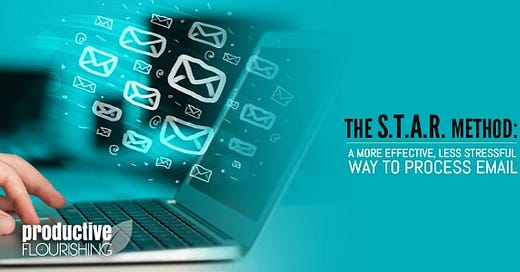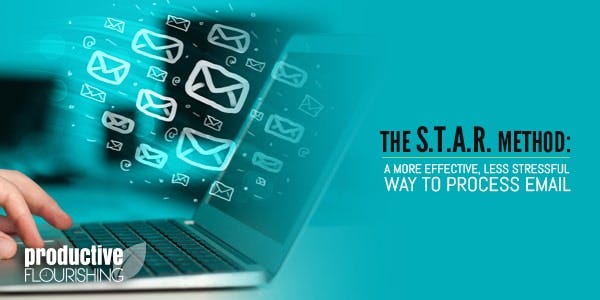The S.T.A.R. Method: A More Effective, Less Stressful Way to Process Email
The goal is not to get to Inbox Zero — instead, it's to have the perspective to consider what needs to be done with your Inbox.
Do you struggle with having a manageable email Inbox? Are you worried that you're missing something important because you can't keep up with the volume of email traffic you're getting? Don't worry, you're not alone — and there's an easier way to have less stress and overwhelm without being anal-retentive and that doesn't require you to learn to be anal-retentive about clearing your Inbox.
I've written a lot about effective email habits, and I've recommended using the R.A.F.T. (Read-Act-File-Trash) method to process your Inbox. Over the course of time, though, I recognized some of the weaknesses of that particular method, and I've changed things up a bit - the process that I've distilled and now recommend is the S.T.A.R. method. Here's a quick breakdown:
S stands for SCAN. Scan your Inbox for senders and subjects. This step gives you a higher perspective of what’s in your Inbox - you have to know where you’re starting from and where you’re going.
T stands for TRASH - as in “trash everything that’s not relevant, useful, or something you want or need.” You may see 60% of the messages in your Inbox disappear from this one step alone.
A stands for ARCHIVE, as in “archive relevant reference information.” A lot of messages just contain information that you want to keep but that don’t require any specific action from you at this time. Archiving them clears them from your attention, and these may account for 20-30% of the messages in your Inbox.
R stands for RESPOND, as in “respond to what’s left.” This is the hardest step, when it comes down to it, as you'll actually have to do more than click on a few buttons. But once you get down this far, you'll have a lot fewer messages, and that alone may give you the motivation to start working through these remaining messages.
The other main difference between the S.T.A.R. method and the R.A.F.T. method is that the goal of the S.T.A.R. method is not to get to Inbox Zero — instead, it gets you to a much more manageable Inbox that lets you have the perspective to consider what needs to be done with your Inbox in the context of everything else you need to be doing.
Why the S.T.A.R. Method Is Better Than the R.A.F.T. Method
When I recommended the R.A.F.T. method, I was heavily influenced by the literature on home and office organizing. The R.A.F.T. method works beautifully for physical stuff, and two years ago, the volume of traffic sent by email wasn't as high as it is today, so it was a great start at an effective email habit.
While R.A.F.T. is great for helping you get your Inbox empty, it is much slower. As the sheer volume of email messages increases, it becomes increasingly harder to actually get through your Inbox by using this method. More importantly, though, the R.A.F.T. method doesn't incorporate two of the best features of modern email clients: 1) the ability to see, almost at a glance, everything that's in your Inbox, and 2) batch processing.
When you're dealing with physical files, you can't see 80 discrete items at once, so you have to process them one at a time. And even if you could see them all at once, you could only shift them around one item at a time. However, email clients do allow you to see many more items at once.
And if you start from a more holistic perspective, you can see that many of the messages don't actually require your attention. With a few clicks of a button, you can get rid of everything that doesn't require your attention quickly, and everything left is something that requires you to do something.
So, rather than having to process and evaluate everything as the R.A.F.T. method recommends, with the S.T.A.R. method you can quickly get to just those things that you should actually be spending time and effort on. This makes the S.T.A.R. method much more effective and efficient.
Spend less time and energy fighting with your Inbox and more time doing other, more meaningful activities - give the S.T.A.R. method a try.
If you'd like to learn more about the S.T.A.R. method, check out Email Triage. It's a product I designed that teaches you how to make rapid, effective decisions about what to do with what you have in your Inbox.





